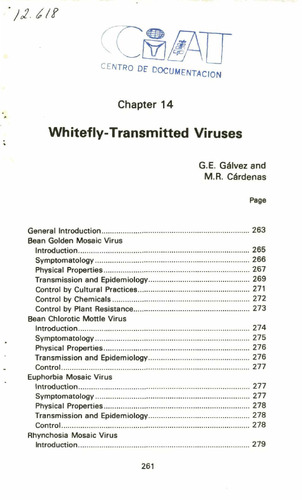Whitefly-transmitted viruses
Whiteflies (Homoptera) are well known for their capacity to transmit 28 plant viruses of beans and other crops. Whitefly populations are generally restricted to tropical zones with alt. greater than 1300 m. Among the viruses transmitted there are: (1) BGMV is an economically important disease especially in regions of L.A., some parts of Central America and the Caribbean. Symptoms are clearly visible; the leaves take on a brilliant yellow or golden color. The virus can be transmitted artificially by inoculation. Diseases incidence can be reduced by eliminating alternative plant reservoirs of inoculum with crop rotation. Planting date should be Programmed so that young plants develop during periods of low temp and high moisture. Whiteflies can be controlled economically, applying insecticides in order to reduce the vector population and incidence of BGMV transmission. Plant resistance is an economical method of control. (2) Bean chlorotic mottle virus produces severe dwarfing of susceptible plants, accompanied by a high proliferation of buds and a bunchy or rosette type of plant development. (3) Euphorbia mosaic virus produces necrotic leaf lesions at feeding sites of whiteflies. (4) Rhynchosia mosaic virus includes a wide host range, causes leaf malformation, yellowing, witches'-broom and plant stunting in young plants. The symptoms and damage caused by the viruses are illustrated in color. (CIAT)

